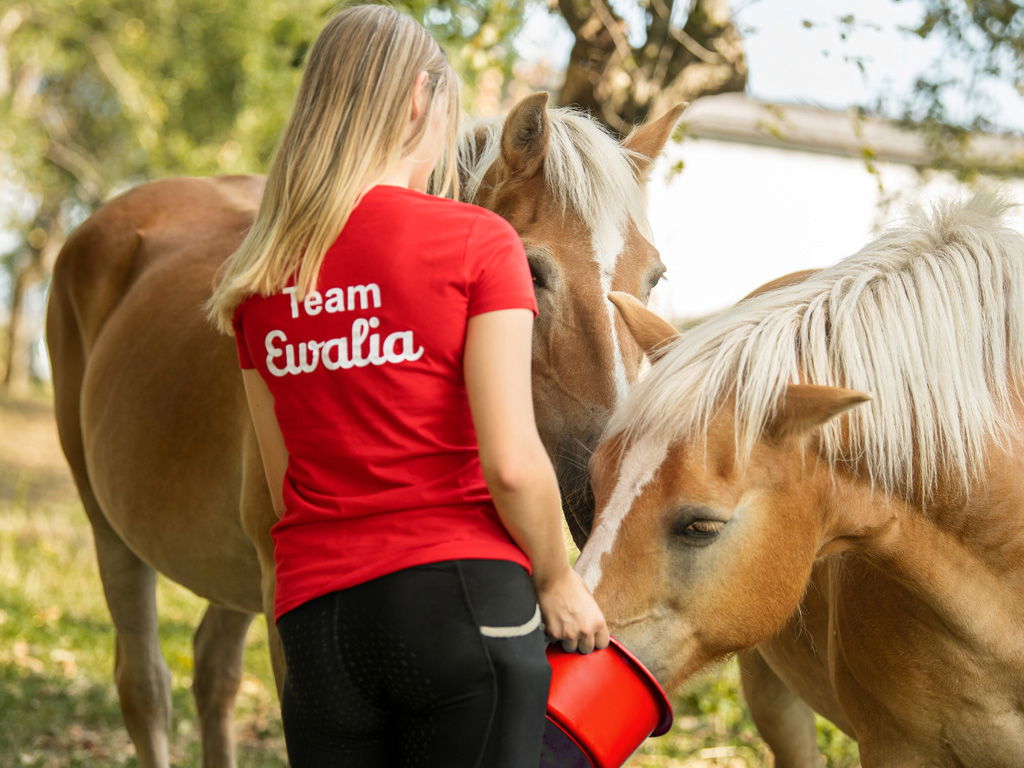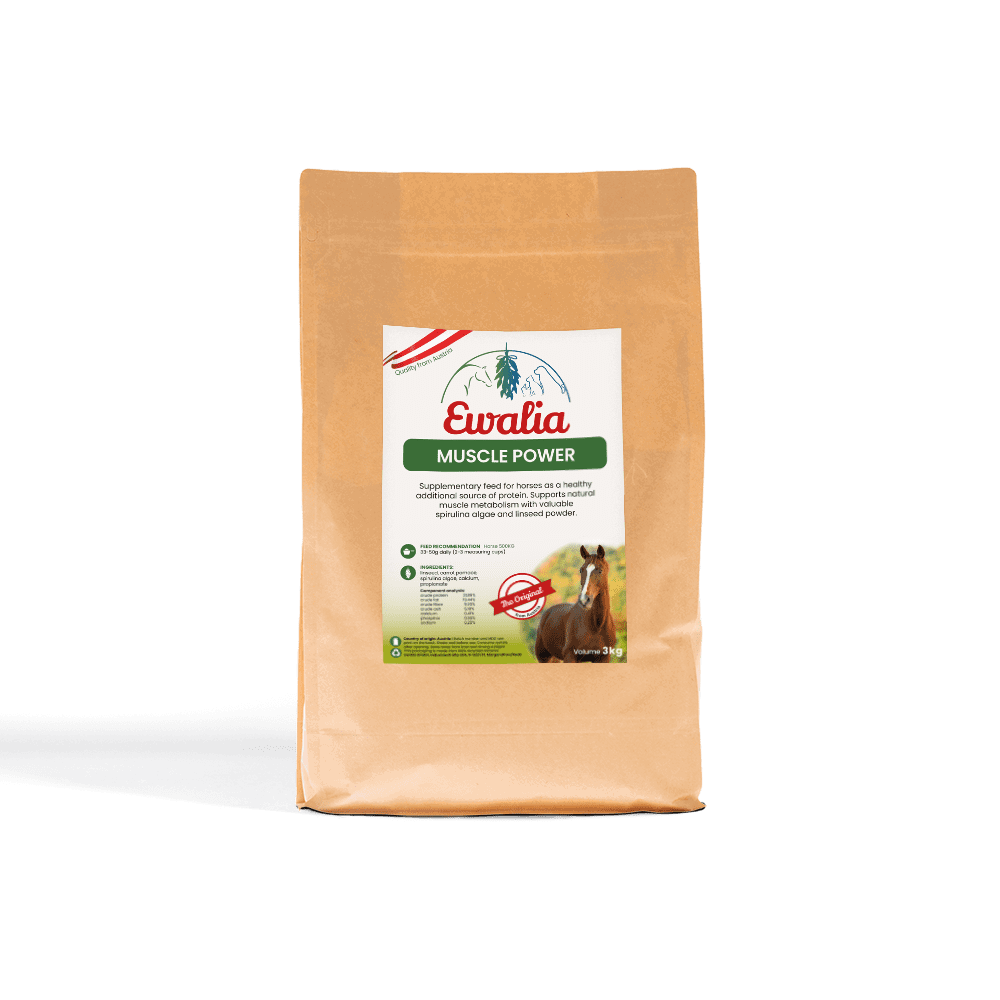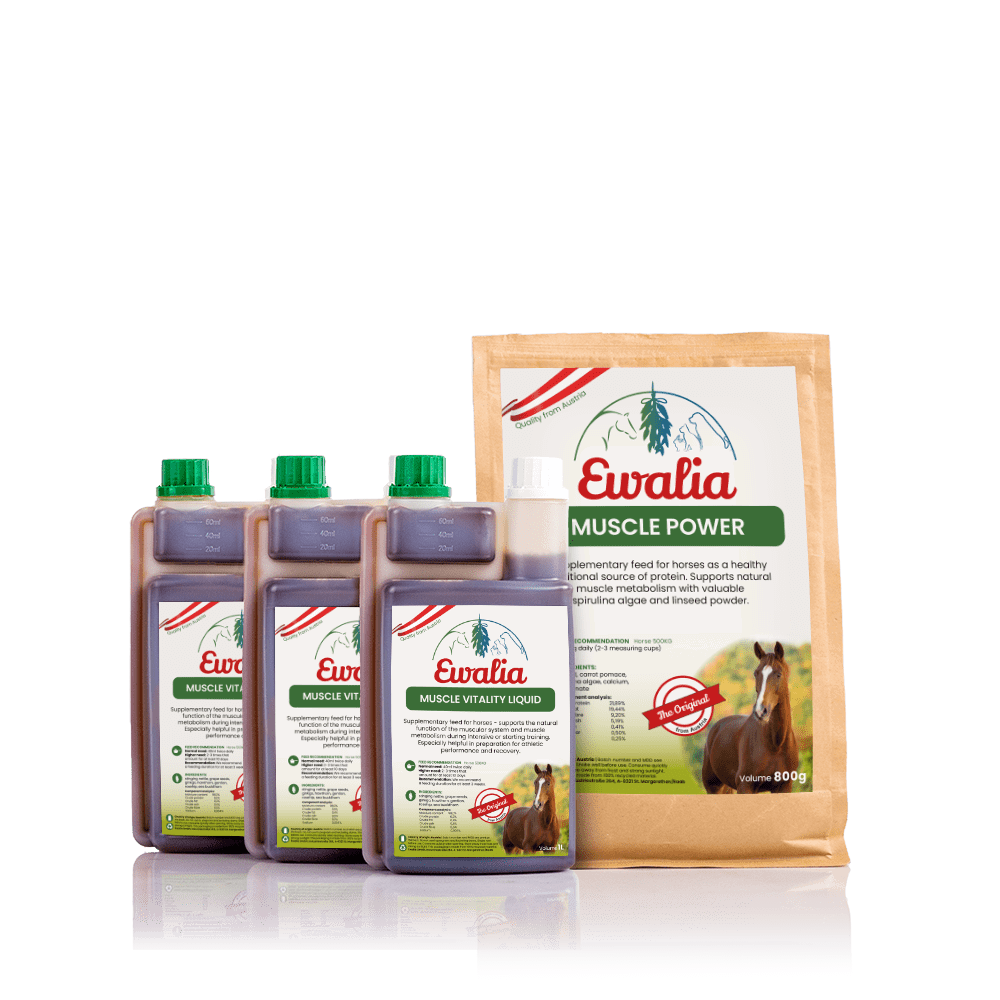PSSM in horses

Equine Polysaccharide Storage Myopathy (PSSM, EPSSM) is a progressive disease of the skeletal muscles with very painful symptoms in acute cases.
Type 1 PSSM and Type 2 PSSM
PSSM was first thought to be a problem specific to Quarter Horses, but was soon found to affect other muscular breeds like Appaloosas, Paints, draught horse breeds, Haflingers and heavy warmbloods. Such breeds are affected mainly with Type 1 PSSM, a variant caused by a genetic mutation. The second variant, Type 2 PSSM can affect all horses, from Arabians to Norikers. Its causes are not yet fully understood. Although both types of PSSM are severe and incurable muscle diseases, horses affected with them can still live long and almost normal lives if given proper management and feeding. Learn about PSSM and how you can support your PSSM horse here.
Muscle metabolism function in healthy horses
Muscles need energy to contract and relax again. This energy is obtained from nutrients and oxygen. The more work a horse's muscles must do, the more energy they need.
Our horses get their energy for muscle metabolism from hay or grass and from concentrate feed. Carbohydrates, their most important nutrients, are broken down into glucose in the small intestine. Whilst the conversion of structural carbohydrates is a slow process, the sugars from (hydrothermally processed) cereals, apples, molasses and other sugary feeds are made available quickly. Part is used immediately by cells of the brain and nervous system. The other part passes into the blood and raises blood sugar. To regulate blood sugar, the pancreas releases insulin which docks onto the receptors of the muscle cells and ensures that the cells absorb sugar from the blood. In the muscle cells, the glucose is converted into glycogen, a polysaccharide which is stored as energy in the muscle. When the muscle is worked, the stored glycogen is converted back into sugar and broken down into carbon dioxide and water with the addition of oxygen. This process releases the energy that the muscle needs to do its work.
What goes wrong in a PSSM horse's muscles
The muscle cells of PSSM horses react much more sensitively to insulin. Even small amounts of insulin released will result in more glucose and polysaccharides being absorbed from the blood, and 1.5 to 4 times more glycogen being stored in the muscle fibres than in a healthy horse. A horse would have to be working non-stop to burn up such an energy supply! Sugar continues to be supplied through food intake, but the muscles cannot store unlimited amounts of glycogen. The excess is converted into starch, from which, however, no energy is obtained. What happens now is a paradox: the original excess energy from the oversupply of glycogen results in an energy deficit in PSSM horses, with a number of symptoms.
Why do horses get Type 1 PSSM?
Type 1 PSSM involves a mutation in the gene GYS1, which can be detected through laboratory tests. This gene encodes an enzyme that converts sugar into glycogen in muscle and is inherited as an autosomal-dominant trait, meaning that a mare that is a PSSM single gene carrier from just one parent is 50% likely to pass the genetic defect on to her foals. If both of the horse's parents have this defect, the condition is passed on 100% to the offspring, increasing the likelihood that the horse and subsequent generations will develop PSSM.
The presence of this genetic mutation, however, does not mean that the horse will definitely have PSSM. Studies have shown that, given appropriate stabling and feeding and depending on breed, about 50% of horses of affected breeds carry the genetic mutation for Type 1 PSSM without developing symptoms. As long as feed intake and physical activity were kept in balance, PSSM outbreaks did not occur, according to these studies. The horses would become ill, however, if they consumed larger quantities of highly digestible carbohydrates. Therefore, there is already discussion as to whether the genetic defect is perhaps a "healthy" mutation in the genetic spectrum of horse breeds. Wild horses had to move a lot when food was scarce, so this ability to use even the smallest increases in blood sugar for energy production would have been an evolutionary advantage.
What are the symptoms of a horse with Type 1 PSSM?
Most Type 1 PSSM horses do not show symptoms until they are being broken in and are given concentrate feed for the first time. At first, the horse owner may notice recurring lameness, irregularities in rhythm and muscle problems, but not immediately associate them with PSSM. The signs become more pronounced as the disease progresses. The horse will seem listless, stiff and unwilling to move, it will tire quickly and begin to sweat after just 10 or 20 minutes of exercise, showing an increased heart rate and heavier breathing. Some horses will try to roll on the ground. Cramps, anxiety and restlessness may be mistaken for colic symptoms. If the horse is forced to continue to exercise, as is recommended for colic, the symptoms will worsen: the horse will sweat profusely and have muscle tremors, will tuck up and stand camped out. The muscles of the hindquarters become painfully stiff and, as in tying-up syndrome (ERS), the horse produces dark-coloured urine (myoglobinuria). The dark colour is from the release of the muscle pigment myoglobin when massive damage to muscle fibres occurs. This myoglobin can severely damage the kidneys. The pressure from the hardened muscles can cause vascular and nerve damage (Compartment Syndrome).
If the horse is pushed further, it may buckle in the hindquarters and fall. Often, the horse may not be able to get back up.
PSSM symptoms usually occur in episodes, with the horse's reluctance to move increasing over time. Regression is seen in the muscles of the back and croup. The horse becomes increasingly gaunt, and the concerned owner, hoping to bulk up the horse, then feeds it more concentrate feed which only worsens the symptoms.
PSSM can affect horses of all ages – foals and young horses less frequently – and the risk increases with age. It affects both male and female animals equally. Notably, it affects leisure horses more often than sport horses. Although not proven, the infamous "Monday morning sickness" suffered by heavy draught horses in the past is assumed to have been Type 1 PSSM. Traditionally, hard-working horses were fed sugary beet pulp. Not being worked on Sundays, if their feed wasn't reduced the day before, they would often fall ill on Monday.
How is a horse determined to have Type 1 PSSM?
A genetic test can determine whether the horse is a carrier of the mutated gene and could develop PSSM. Testing involves either a blood sample or a hair sample from 20 to 30 hairs, with roots, taken from the mane or tail. In Europe, there is currently only one laboratory carrying out such tests; results are available after a week. Breeding associations of the affected breeds already stipulate genetic testing. The laboratory results are binding – horses with the GYS1 mutation are not permitted to breed.
Haemogram during an acute episode: measurements are taken of the muscle-specific enzymes creatine kinase (CK) and aspartate transaminase (AST) in the blood. Many PSSM horses have already-high levels at rest; with light physical activity these levels increase by several times over normal values. However, these values may be distorted if the horse becomes agitated when the blood sample is taken.
The surest way to determine PSSM is through a muscle biopsy. Here, the horse is sedated and a sample of deep muscle tissue removed; this sample must then be examined in the laboratory as quickly as possible. The muscle biopsy can be used to distinguish PSSM from other muscle diseases such as spontaneous exertional rhabdomyolysis or shivers.
What is the difference between Type 1 PSSM and Type 2 PSSM?
Scientific research on PSSM only began in the early 2000s. Many of the examined horses showed very similar symptoms and had similar biopsy results, but some lacked the GYS1 mutation responsible for Type 1 PSSM. "Type 2 PSSM" was introduced as a collective term for muscle diseases not caused by genetic defects affecting glycogen storage. Recent research methods have shown that Type 2 PSSM involves defects in the muscle structures that lead to myofibrillar myopathy (MFM). The disease' s connection with gene mutations has only recently been proven. Four genetic variants for Type 2 PSSM have been found as a semi-dominant trait which can affect almost all horse breeds with the exception of Icelandic horses. Affected Icelandics carry an as-yet-unknown genetic mutation.
As with the GYS1 mutation, not all carriers of the gene mutations responsible for Type 2 PSSM become symptomatic. Acute episodes of Type 2 PSSM occur when genetically affected horses consume more protein than they need, for example if they are exposed to great stress, or in cases involving illnesses, injuries or surgeries. Some horses have sensitive reactions to vaccines, in which case vaccinations should be spread out over a longer period of time. With good management conditions and a proper diet, the affected horse may develop only mild symptoms or none at all. Type 2 PSSM has no cure, however.
The first symptoms appear in the horse's 7th to 10th year, well after reaching sexual maturity. This may be the reason why the mutations have been able to spread so greatly: many horses are retired from sport around this age due to lameness or other physical limitations, and put into breeding.
What occurs in Type 2 PSSM?
Type 2 PSSM is a progressive disease with muscle breakdown caused by a defective build-up of structural proteins in the muscle cells. It does not involve a disturbance of carbohydrate metabolism.
In Type 2 PSSM, an abnormal distribution of glycogen in the muscle makes it appear on histological examination that there is too much glycogen stored in the muscle cells. Simply put, the building blocks of the muscle cells can no longer be produced correctly, and so the muscle will become increasingly weaker. A horse with Type 2 PSSM needs much more protein compared to a healthy horse, because its body is constantly trying to supply the muscles with proteins.
However, a protein deficiency in stressful situations, such as when the horse is injured or ill and requires more protein, will trigger Type 2 PSSM episodes in affected horses. A negative nitrogen balance (when the body uses more protein than it takes in) can bring on acute phases of muscular atrophy. When the horse needs energy for performance, no fuel can be made usable for the cells. The cells are destroyed and must be broken down by the body. The result is muscle pain, muscular atrophy and massive strain on the kidneys. However, suitable adaptations to the horse's management and diet will keep it from developing any symptoms.
Blood tests from Type 2 PSSM horses often show CK and AST levels within the normal range. The commonly used designation "Type 2 PSSM" is actually not quite accurate here as there is no glycogen storage defect.
What are the symptoms of a horse with Type 2 PSSM?
A Type 2 PSSM horse will not show clear symptoms of the disease at first. There can be many reasons why a horse that was previously full of energy begins to show increasing listlessness and weakness. Being in pain, it appears tense uncooperative. It displays resistance behaviour under the saddle or during visits by the vet or farrier. Trainers are consulted, manual therapies applied, and changes made to feed, but the horse's condition does not improve. There are occurrences of shifting lameness. The horse's gait may be ataxic or uncoordinated, with stiffness in the hindquarters and generally little scope. Equine rhabdomyolysis syndrome is comparatively less common in Type 2 PSSM. As the disease progresses, there is severe muscle atrophy in the hindquarters, shoulders and topline; some horses show localised muscle loss, resulting in "divots" in the musculature which are sometimes mistaken for injuries from kicking.
A special variant of the gene mutation called the Px variant occurs in hot-blooded horses such as thoroughbreds and Arabians as well as in light warmbloods, causing recurrent exertional rhabdomyolysis, or RER. The symptoms occur in episodes during stress and strain, particularly during the training of very nervous, easily excitable horses. Racehorses in training, especially two-year-olds(!), often suffer from RER. In young horses, mares are more susceptible to RER than stallions and geldings. Typical symptoms include reluctance to move, extreme nervousness, tension, muscle tremors, dark-coloured urine, and profuse sweating. CK and AST activity is shown to be high in the blood of RER horses. The disease is probably triggered by a dysfunction of the calcium-dependent mechanism that regulates the contraction and relaxation of muscle.
How is Type 2 PSSM diagnosed?
Type 2 PSSM can be distinguished from other muscle diseases through genetic testing. A genetic test can be carried out on horses of any age and even before symptoms appear, for example as part of a pre-purchase vetting or before breeding use. This test is definitely recommended for horses with unexplained lameness and/or severe muscle loss and poor performance!
Muscle biopsies are only useful during acute episodes, as a sample cannot indicate Type 2 PSSM outside the acute phase.
What are important factors in the keeping of a PSSM horse?
Whether the horse is merely a carrier of a mutated gene or has already fallen ill are key factors in its management. PSSM horses benefit from reliable daily routines, reduction of stress and regular exercise in any case. For RER horses in particular, well-planned stress management in their stabling makes a lot of sense; any excitement should be avoided.
Turnout with other horses provides activity and relieves boredom, giving the horse the opportunity to move about freely and stay fit. Stall confinement for PSSM horses is counterproductive.
Can a PSSM horse be trained?
Regular training can be very helpful depending on the horse's condition. In fact, horses that do not show any symptoms urgently need training in order to reduce the excessive storage of glycogen! However, training intensity should only be increased slowly and very carefully, if at all. Under no circumstances should the horse be overworked! Exercise twice a day would be ideal but is difficult for most horse owners. Basically, the following applies: The fitter and more content the PSSM horse, the lower the risk of an outbreak or episode of PSSM and the higher its life expectancy.
Caution: Manual therapies that activate the musculature and can boost well-being should not be used on PSSM horses!
What are important factors in the feeding of PSSM horses?
For the horses themselves, Type 1 PSSM means one thing above all: a lifelong diet. Type 1 PSSM horses, both those genetically predisposed and those already showing the disease, have a very poor tolerance to highly digestible sugars. Easily digestible feed containing sugar, starch and protein should be replaced with ample quantities of hay, the minimum amount being 1.7 kg hay per 100 kg of the horse's body weight. Silage and haylage are unsuitable for Type 1 PSSM horses due to their acidic pH value. Also blacklisted, unfortunately, are popular rewards like apples, carrots and other treats. Soaked hay pellets make a suitable alternative, allowing the horse a daily highlight and preventing the frustration of standing in front of an empty trough.
Intervals between meals should not exceed four hours. Between meals, you can keep your horse happy with twigs or straw to nibble on. Concentrate feed should only be used if the horse needs energy for extra work, and then only in minimal quantities. Several small portions of concentrate feed with easily digestible carbohydrates are better than one or two large portions, as the former won't result in blood sugar spikes. Always give your horse hay before concentrate feed; this helps to regulate blood sugar through slow-release concentrates.
Numerous studies have shown that switching feeds will lead to a significant improvement in muscle metabolism of Type 1 PSSM horses. Vegetable oils can be used in place of starchy cereals to meet higher energy requirements. Type 1 PSSM horses generally have higher fat requirements. Recommended fat sources include rice bran, maize germ oil, sunflower oil, and especially linseed oil, which is also anti-inflammatory due to its omega-3 fatty acids. Allow the horse to get slowly accustomed to higher doses of oils, as PSSM horses don't tolerate sudden changes in feed particularly well.
There are already sugar-reduced and starch-reduced ready-to-feed mixtures on the market for Type 1 PSSM horses – we advise that you read the ingredients carefully.
In horses with Type 2 PSSM it is not very meaningful to reduce sugar in the feed to relieve symptoms, because there is no disturbance of the carbohydrate metabolism or the glycogen storage in the muscle. Type 2 PSSM horses have increased protein requirements. Stress and performance demands can temporarily increase the protein requirements of Type 2 PSSM horses to six times that of healthy horses! However, as horses with RER tend to be agitated and tense, it's best to avoid feeding them too much concentrate feed. An alternative is a diet high in fat and protein.
Supplementing the feed with the amino acids lysine and methionine will have a positive effect on the muscles. In addition, a recent study concludes that muscular damage is caused by protein oxidation and a shortage of antioxidants, so a dietary supplement with antioxidants might help to relieve symptoms.
Do PSSM horses need mineral feed with extra vitamins?
Most feed mixes are enriched with vitamins and minerals. If you reduce this feed or dispensed with it altogether, you should pay special attention to the vitamins and minerals required for PSSM horses. The mineral feed should contain as little sugar as possible, of course!
Vitamin E is indispensable for equine muscle tissue, as it promotes cell regeneration and has antioxidant effects. High doses of vitamin E can improve symptoms in PSSM horses.
Caution: Vitamin E requirements increase when feeling oils!
Selenium, like vitamin E, protects cell membranes and is a radical scavenger. It helps loosen rigid muscles and increases performance.
Stress in combination with PSSM can lead to a vitamin C deficiency.
Vitamin B is vital to nerve health.
Electrolytes can bring short-term improvement to blood circulation in muscle.
Horses that sweat profusely may need sodium chloride (NaCl, common salt), as they can no longer absorb the required amounts from a salt lick. NaCl also promotes water retention.
Horses with muscle loss and muscular diseases need essential amino acids; these can be found in numerous feeds including lucerne, dried brewer's yeast and mineral mixes. The essential amino acids L-carnitine, L-lysine and methionine have positive effects on muscle cells.
How else can I support my PSSM horse?
Omega-3 fatty acids have anti-inflammatory and antioxidant properties. These are found in linseed oil, linseeds and spirulina. Spirulina also provides essential amino acids and vitamin B. Grape seed extract (OPC) shortens the regeneration time of muscle.
Herbs for PSSM horses:
Rose hips have lots of vitamin C. Sea-buckthorn also contains a high amounts of vitamin C as well as vitamin E, vitamin B, and essential amino acids.
Nettle, birch leaves and dandelion promote detoxification and support kidney function.
Hawthorn stimulates and supports blood circulation.
Ginkgo is an antioxidant that promotes blood circulation and can help build muscle tissue.
Acute PSSM – what to do whilst waiting for the vet
A horse experiencing a PSSM episode must be given veterinary treatment immediately. Horses are flight animals; the combination of extreme pain and the inability to move triggers feelings of panic. Bring the horse into a box with generous bedding to prevent injury from a fall. If symptoms should appear outside far away from the barn, it's better to organise a trailer than to lead the horse home on foot – and riding home is completely out! Whilst waiting for the vet to arrive, the horse should be kept quiet, covered and warm – possibly with an infra-red lamp – and as still as possible. Offer water to prevent dehydration, as this can lead to kidney damage!
Sources and further reading
- Coenen, M., & Vervuert, I. (2020). Pferdefütterung (6. Ausg.). Stuttgart: Georg Theme Verlag KG.
- Cox, M., & Hoffmann, H. (02 2019). PSSM2-erblich bedingte Muskelerkrankung. Professional Pferd.
- Fritz, C., & Maleh, S. (2016). Zivilisationskrankheiten des Pferdes. Thieme.
- Gerber, V., Venner, M., & Straub, R. (2016). Pferdekrankheiten: Innere Medizin (2. Ausg.). (V. Gerber, & R. Straub, Hrsg.) Bern: utb.
- Szauter, P. (13. Oktober 2019). EquiSeq. Von Arabian MFM: http://equiseq.com/blog/arabian-mfm abgerufen

















